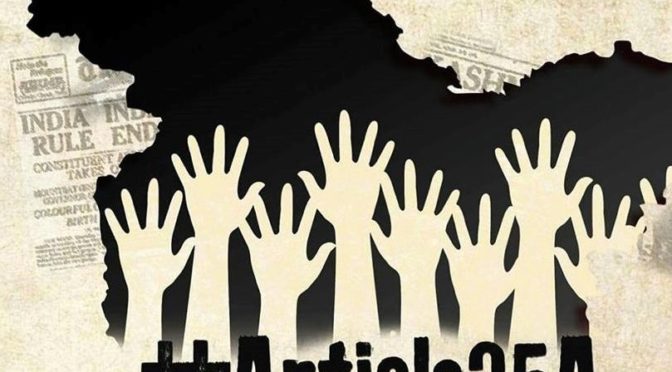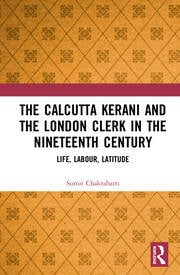THE CONUNDRUM OF ARTICLE 35A: A TRANSGRESSION UPON THE CONSTITUTION, OR A NECESSARY EVIL?
Posted on : September 23, 2018Author : AGA Admin

Ever since the promulgation of the Presidential Order, the Constitution (Application to Jammu and Kashmir) Order of 1954, through which Art 35A was born, the same has riled much controversy in the legal circles, and indeed now in the political circles.
As a student who had just entered my second-year of Law School, it had befuddled me when one fine day, deliberating upon exceptions to the principle of ‘Equality before Law’ enshrined under Art. 14, the Constitutional Law Professor mentioned an unheard of constitutional provision which found no mention in the Constitution. Poring through the Bare Act, it was discovered that the Bare Acts do not provide for Art. 35A in their texts. The supposed reason for its absence is attributed to its existence deriving from promulgation through the Presidential Order, and not through the constitutionally provided for amendment mechanism.
ART. 370, 35A, AND THE INSTRUMENT OF ACCESSION OF 1947
On October 26, 1947, Maharaja Harish Singh of the Kingdom of Jammu and Kashmir signed the Instrument of Accession acceding to India after Pakistan’s violation of a Standstill Agreement signed in 1946. Along with this Instrument were various conditions imposed which infamously grant the quasi-sovereign nature to the state.
These provisions were the foundation for Art. 370, which granted ‘special status’ to the state of Jammu and Kashmir. Important to note is the heading of Art. 370, which reads as follows: “Temporary Provisions with respect to the State of Jammu and Kashmir”, enumerating that the said status was understood to be only a temporary provision, till the State was fully integrated as any other state. The 3rd sub-clause to the said Article attests to this understanding when it provides to the President the power, upon the recommendation of the Constituent Assembly of the state of J&K, to cease effect of Art. 370.
Art. 370, however, is not the subject matter of this article. Its importance lies in the fact that it is through Art. 370, that Art. 35A flows. Art. 35A is often said to evince the special understanding enumerated in Art. 370. The Delhi Agreement of 1952 between Nehru and then Prime Minister of J&K, Sheikh Abdullah brought about Art. 35A. It enables the state legislature to define “permanent residents” and provide them with special privileges. These special privileges include inter alia rights relating to employment under the State Government, acquisition of land, settlement, scholarships. It also protects such laws from being held as void on the ground that they are inconsistent with or restrict or abridge any rights conferred on the other citizens of India by the Fundamental Rights.
ART. 35A: THE TRANSGRESSIONS
Art. 35A has been contested in the legal circles upon two prime grounds: One that it is violative of Art. 368, and the second that it is violative of Art. 14.
For a layman, the grounds are as such:
i. Contest under Art. 368
Assertion: Art. 368 of the Constitution of India provides for the modus through which the Constitution can be amended. Under this Article, the Parliament has the power to amend the Constitution, and the role of the President is restricted to only providing assent to any Amendment once the Amendment Bill has passed in both the House. This modus does not provide for a manner whereby Constitution can be amended by any other manner, and hence, the legality of Art. 35A, which was introduced through a Presidential Order with the Parliament kept in the dark, is challenged.
Rebuttal: The rebuttal to this argument relies upon Art. 370(1)(d) which provides for the power to the President to modify Articles of the Constitution with relation to their application to the State of J&K. In Puranlal Lakhanpal vs The President Of India 1961 AIR 1519, as well as in State Bank Of India vs Santosh Gupta (2017) 2 SCC 538, the Supreme Court held that in light of Art. 370(1)(d), and the special relationship accorded to J&K as a whole under Art. 370, the widest possible amplitude of interpretation needs to be given to the power of the President to modify the Constitutional provisions with respect to J&K, and that includes the power to amend the Constitution.
That, is in reference to modification of Articles. Whether the President has powers to insert new provisions altogether, and whether Art. 35A shares the similar privilege is a matter sub-judice before the Hon’ble Supreme Court in the case raised by the NGO, ‘We the Citizens’.
ii. Contest under Art. 14
In another case, which the Supreme Court bench hearing the matter on 35A has clubbed with the ‘We the Citizens’ case, Charu Wali Khanna, a Supreme Court advocate instituted a case under Art. 14, arguing that provisions of 35A granting ‘permanent residents’ special privileges and rights is violative of Art. 14 of the Constitution of India – which grants right to equality to all citizens.
The concept of Permanent Resident
The J&K Constitution adopted on November 17, 1956 defines, under Art. 6, Permanent Resident as a citizen of India who is a “state subject of Class I or of Class II” or someone who has lawfully acquired immovable property and has ordinarily been a resident of the state for 10 years prior to May 14, 1954. It only empowers J&K legislature to alter definition of PR only through law passed by two-thirds majority.
The provision of Permanent Resident bars Indian citizens, other than permanent resident of J&K, from settling in state, acquiring immovable properties, seeking employment or undertaking any trade or business if state makes any law to that effect and it cannot be challenged before any court. It also denies property rights to woman who marries a non-permanent resident and her children.
Assertion: Through this challenge, the petitioner had raised the grounds that Art 35A simply denies women who marry non-permanent residents and their children from inheriting property in the State, whereas the same is not applicable when men marry non-residents.
Rebuttal: It is not contested that Art. 35A is discriminatory towards women. In State of Jammu and Kashmir versus Dr Susheela Sawhney AIR 2003 J K 83, the J&K High Court gave a prodigious judgment whereby women, and their children who were permanent residents of the state could not be denied that status if she married non-permanent residents. Moreover, it is also argued in some circles that for the discrimination to end, there need not be invalidation of Art 35A, but a mere application of Art. 14 upon a particular provision of 35A rendering the part, and only the discriminatory part, void, and leaving the remainder of 35A functional.
ART. 35A: PLAYING WITH FIRE?
Art. 35A is particularly complicated because of the sentiments associated therewith in the Kashmir Valley. 35A might have its banes, but playing with the legality of it has been associated as akin to playing with fire, especially in light of the recent turmoil in the valley. 35A was a conciliatory provision, a sort of win-win for the political circles in Delhi and Srinagar, one which extend Indian citizenship to all in Kashmir, whilst simultaneously exacting a provision for permanent residents of the State. Though the Supreme Court ought to function regardless of political ramifications, it is indubitable that any judgment going whichever way is bound to rile further conflicts, and it becomes incumbent upon the political circles in both Delhi and Srinagar to play with this fire carefully, lest it engulfs the Valley into further tensions.
Mohit Dang
Intern
23.09.2018





Leave a Reply